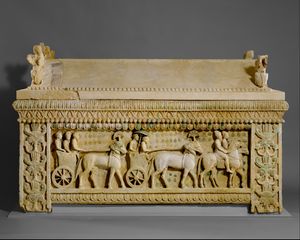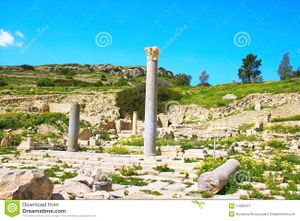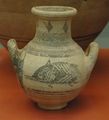أماثوس
Ἀμαθοῦς | |
 تابوت أماثوس من القرن الخامس ق.م.، عُثر عليه في أماثوس، وتظهر فيه سمات يونانية وقبرصية وشرقية | |
| الاسم البديل | Amathus, Amathous |
|---|---|
| المكان | قبرص |
| المنطقة | محافظة ليماسول |
| الإحداثيات | 34°42′45″N 33°08′30″E / 34.71250°N 33.14167°E |
أماثوس (Amathus أو Amathous؛ باليونانية قديمة: Ἀμαθοῦς) كانت مدينة قديمة وواحدة من المدن الملكية في قبرص حتى نحو سنة 300 ق.م. ومازالت بعض آثارها البديعة بادية للعيان على الساحل الجنوبي مقابل آگيوس تيخوناس، على بعد 39 كم غرب لارناكا و 9.7 كم شرق ليماسول. ومقر عبادتها القديمة لأفروديت كان ثاني أهم تلك المعابد في بلدها قبرص، بعد پافوس.[1][2]
مؤخراً، استؤنف التنقيب عن الآثار في الموقع والعديد من اللقى معروض في متحف ليماسول.
التاريخ
قبل التاريخ والعصر القديم
ما قبل التاريخ في أماثوس يمزج الأسطورة وعلم الآثار.[3] فعلماء الآثار عثروا أدلة على نشاط بشري من العصر الحديدي المبكر، حوالي سنة 1100 ق.م.[2][4] مؤسس المدينة الأسطوري كان كنيراس، المرتبط بميلاد أدونيس، الذي سمّى المدينة على اسم أمه، أماثوس Amathous. وحسب نسخة من أسطورة أريادنى ذكرها پلوتارخ,[5] Theseus abandoned Ariadne at Amathousa, where she died giving birth to her child and was buried in a sacred tomb. According to Plutarch's source, Amathousians called the sacred grove where her shrine was situated the Wood of Aphrodite Ariadne. More purely Hellenic myth would have Amathus settled instead by أحد أبناء هرقل، thus accounting for the fact that he was worshiped there.
It was said in antiquity that the people of Amathus were autochthonous, or "Pelasgian".[2] Their non-Greek language is confirmed on the site by Eteocypriot inscriptions in the Cypriot syllabary which alone in the Aegean world survived the انهيار العصر البرونزي المتأخر وواصلت البقاء حتى القرن الرابع ق.م.

معرض صور
أمفورا من المقبرة 52، أماثوس، القرن السادس ق.م.، المتحف البريطاني.
نسخة من مزهرية حجرية كبيرة، في الموقع الذي وُجـِدت فيه (الأصل في اللوڤر)
الهامش
- ^ Walter Burkert, Greek Religion 1985, p. 153; J. Karageorghis, La grande déesse de Chypre et son culte, 1977.
- ^ أ ب ت Catling, Hector William (1996). "Amathus". In Hornblower, Simon; Spawforth, Anthony (eds.). Oxford Classical Dictionary (3rd ed.). Oxford: Oxford University Press. ISBN 0-19-521693-8.
- ^ T. Petit, "Eteocypriot myth and Amathousian reality," JMA 12 (1999:108-20)
- ^ Aupert, Pierre (November 1997). "Amathus during the First Iron Age". Bulletin of the American Schools of Oriental Research. 308 (308): 19–25. doi:10.2307/1357406. JSTOR 1357406.; M. Iacovou, "Amathous, an early Iron Age polity in Cyprus: the chronology of its foundation", Report of the Department of Antiquities of Cyprus (2002) pp 101-22.
- ^ Plutarch, vita of Theseus (20.3-.5), citing the lost text of an obscure Amathusan mythographer, Paeon.
المراجع
- Richard Stillwell, ed. Princeton Encyclopaedia of Classical Sites, 1976: "Amathous, Cyprus"
- Municipality of Limassol




